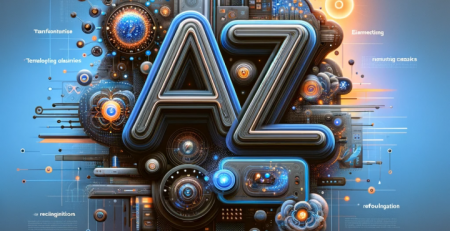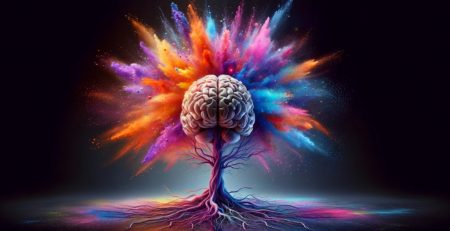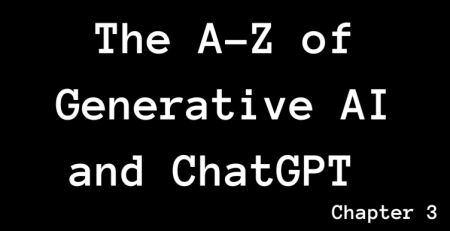The A-Z of Generative AI and ChatGPT – Chapter L
Generative AI is poised to unleash the next wave of productivity.
Generative AI stands at the forefront of technological innovation, poised to transform the way we create, interact, and experience the world around us. Its ability to generate entirely new content and augment human creativity holds immense promise for solving complex challenges, fostering innovation, and unlocking new frontiers of knowledge.
While challenges remain in ensuring the responsible and ethical development of generative AI, its transformative potential is undeniable. As generative AI continues to evolve, we can anticipate a future of limitless possibilities, where machines and humans collaborate to shape a brighter future for all.
But to understand how it will do so, you need to take your productivity, employability, and business to the next level by reading my carefully curated series on Generative AI.
Welcome to the A-Z of Generative AI where each week I will give you an explanation of every aspect of this exciting new technology beginning with the letter A and ending with the letter Z. You will learn all there is to know about Generative AI in this series to rapidly level up your job prospects, your productivity, and your business.
Why is Generative AI Causing Such Excitement?
Generative AI, a ground-breaking branch of artificial intelligence, has captured the imagination of researchers, industry leaders, and the general public alike. Its ability to produce entirely new content, from captivating images and melodies to compelling narratives and innovative product designs, has sparked a wave of excitement and anticipation.
But to fully comprehend the underlying reasons for this enthusiasm, it is crucial to delve into the unique capabilities and transformative potential of generative AI.
A Paradigm Shift in Content Creation
Generative AI represents a paradigm shift in content creation, ushering in an era where machines can not only analyse and interpret existing data but also generate entirely new forms of expression. This remarkable ability stems from the intricate algorithms employed by generative AI models, which are trained on vast troves of data to extract patterns and underlying structures.
By understanding the statistical relationships within the training data, these models can generate novel outputs that adhere to the inherent characteristics of the data they have learned from.
Unleashing Creativity and Innovation
The impact of generative AI extends far beyond the realm of mere automation. It empowers individuals and organizations to unleash their creativity and drive innovation across a wide spectrum of industries. In the field of design, generative AI can assist in crafting novel concepts, optimizing product designs, and tailoring experiences to individual preferences.
For marketing and advertising, generative AI can produce personalized content that resonates with target audiences, enhancing brand engagement and driving conversions. In the realm of entertainment, generative AI can revolutionize storytelling, crafting captivating narratives and immersive experiences that captivate audiences.
Industry-Specific Applications
The transformative power of generative AI is not limited to creative endeavours. It is poised to revolutionize various industries and disciplines, unlocking new possibilities and enhancing existing processes.
In healthcare, generative AI can aid in drug discovery and medical imaging analysis, accelerating the development of life-saving treatments.
In finance, generative AI can optimize investment strategies and predict market trends, fostering informed decision-making. In education, generative AI can personalize learning experiences, tailoring instruction to individual needs and enhancing student engagement.
Fostering Collaboration and Amplifying Human Potential
Generative AI is not meant to replace human creativity; rather, it serves as an invaluable tool that can augment and amplify human capabilities. By collaborating with generative AI models, individuals can explore new ideas, refine their creative processes, and achieve remarkable results. This synergistic relationship will foster innovation and lead to breakthroughs that were previously unimaginable.
What Are Large Language Models (LLMs) ?
Generative AI (#GenAI) and Large Language Models (#LLMs) has been all over the news, but apps like OpenAI’s ChatGPT or Google’s Bard are only scratching the surface of what this technology can do.
But what are LLMs and How do They Work?
Technical Explanation:
LLMs are the machine learning models specifically designed for NLP or NLU tasks. While LLMs are primarily concerned with language, similar Generative AI models can serve different purposes such as text-to-image, or audio-to-text, among others. These models can transform data between multiple modalities, including text, images, video, and audio.
A Less Technical Explanation:
Large language models (LLMs) are computer programs that can understand and generate human-like language. They are trained on vast amounts of text data and use statistical methods to learn the patterns and structures of language. LLMs are capable of performing a wide range of natural language processing tasks, such as language translation, question answering, and text summarization.
An analogy for LLMs could be a chef who has access to a vast collection of recipes and ingredients. Just as a chef can use their knowledge of ingredients and recipes to create new dishes, LLMs can use their understanding of language to generate new text.
The more recipes and ingredients a chef has, the more creative and diverse their dishes can be. Similarly, the more text data an LLM is trained on, the more accurate and diverse its language generation capabilities become.
However, just as a chef needs to be careful with the ingredients they use to avoid creating something unappetizing, LLMs need to be carefully trained and monitored to avoid generating biased or harmful language.
Link to useful article: Large Language Models (LLMs): Concepts & Examples – Analytics Yogi (vitalflux.com)
How Does the Future Look Like for GenAI?
I am a financial technology expert with a background in operating automated trading systems. I’m excited about the role that generative AI can play in reducing outages in complex business operations driven by sophisticated technology. As the systems grow increasingly automated, the harder it is to monitor all the data related to the health of that system.
The world’s total data will soon reach the yottabyte (YB). The largest unit approved as a standard size by the International System of Units. A quadrillion gigabytes (GB). Traditional technologies are completely unable to cope with this.
Generative AI will be instrumental in processing all the data, generating alerts when needed, and suggesting remediation steps. This will save businesses billions in remediation costs by preventing outages and freeing time for strategic work.
Letter L
1. Latent Space in Generative AI 🅻
Latent Space in Generative AI refers to a multidimensional representation where AI models map inputs and learn to generate meaningful outputs. It’s like a hidden canvas where creative ideas take shape. Latent space representations enable AI models to disentangle underlying features and create diverse and coherent content.
Real-World Example: An AI-powered character creator uses the latent space to generate unique and expressive avatars.
Example Prompt: “ChatGPT, explore the latent space to enhance your creativity in generating diverse and imaginative responses to user prompts. Design an AI-powered character creation system that utilizes the concept of latent space to generate distinctive and expressive avatars for users. This system should map user inputs to a multidimensional latent space where complex features and characteristics are encoded.
The AI will then interpret these inputs within the latent space to produce avatars that are not only unique but also coherent and full of personality. The model should be capable of understanding and manipulating a wide range of features such as facial expressions, body shapes, and attire, allowing for the creation of avatars that accurately reflect the diverse preferences and creative desires of users.”
2. Long Short-Term Memory (LSTM) in Generative AI 🅻
Long Short-Term Memory (LSTM) is a type of recurrent neural network used in Generative AI. It’s like having a memory lane for AI models to retain important information from past inputs. LSTMs enable AI models to handle sequential data and generate contextually rich content.
Real-World Example: An AI-powered chatbot utilizes LSTM to remember past user interactions and maintain coherent conversations.
Example Prompt: “ChatGPT, leverage LSTM to improve the flow and coherence of your responses during extended conversations. Develop an advanced AI-powered chatbot that employs Long Short-Term Memory (LSTM) networks to enhance conversational continuity. The chatbot should be trained to remember key points from past user interactions, allowing it to maintain context and coherence throughout conversations. It should recognize and build upon previous dialogue, questions, or preferences expressed by users, thereby facilitating a more natural and engaging interaction. Tailor the chatbot’s responses to reflect the user’s conversational history, ensuring each interaction feels personalized and informed by prior exchanges.”
3. Linguistic Style Transfer in Generative AI 🅻
Linguistic Style Transfer in Generative AI involves modifying the style of content while preserving its meaning. It’s like translating a piece of writing into different literary styles while maintaining the original message. Linguistic style transfer allows AI models to create content in various tones and genres.
Real-World Example: An AI writing assistant performs linguistic style transfer to generate a formal or casual version of a given text.
Example Prompt: “Create an AI writing assistant that specializes in linguistic style transfer, capable of rewriting texts to match a specified tone while maintaining the original message. This assistant should analyze the input text and apply linguistic transformations to convert it into the desired style, whether formal, casual, or any other specified genre. The output should reflect the chosen stylistic attributes, such as vocabulary level, sentence structure, and expressions, without altering the core information or intent of the input. For example, the assistant can take an academic paper’s abstract and convert it into a simplified summary for a general audience, or adapt a casual blog post into a formal article suitable for professional publications
4. Level of Creativity in Generative AI 🅻
The Level of Creativity in Generative AI relates to the novelty and originality of content generated by AI models. It’s like measuring the uniqueness of an artist’s creations. AI models can be tuned to produce conservative or highly imaginative content based on specific use cases and user preferences.
Real-World Example: An AI art generator provides users with options to adjust the level of creativity, from replicating famous art styles to producing abstract and unique compositions.
Example Prompt: “Design an AI art generator that offers a slider for creativity levels, enabling users to adjust the novelty and originality of the artwork created. This tool should provide options ranging from conservative, where the AI replicates well-known art styles, to highly imaginative, where the AI is encouraged to produce abstract and unique compositions. Users should be able to specify their desired level of creativity, and the AI will generate art accordingly, ensuring that the outputs can either echo the familiarity of traditional styles or explore the boundaries of artistic expression. The AI should take into account elements like color schemes, brush strokes, and thematic elements to align with the selected level of creativity.”
5. Language Models in Generative AI 🅻
Language Models in Generative AI are algorithms designed to understand and generate human language. It’s like having a language expert who can construct coherent sentences and paragraphs. Language models power various Generative AI applications, including chatbots, language translation, and text generation.
Real-World Example: A language model is employed in an AI-powered virtual assistant to provide informative and contextually relevant responses to user queries.
Example Prompt: “ChatGPT, enhance your language model to better understand and generate responses tailored to different user intents. “Develop an AI-powered virtual assistant that leverages advanced Language Models for generating human-like, contextually relevant responses. The model should be able to parse user queries, understand the nuances of human language, and construct coherent, informative replies that are tailored to the user’s needs.
Whether it’s for setting reminders, providing weather updates, or offering complex technical support, the language model should adapt its responses to fit the context and maintain a natural flow of dialogue.
Ensure the assistant is capable of learning from interactions to improve its language understanding and response accuracy over time, making it an indispensable tool for users seeking quick and reliable information.
6. Language Generation in Generative AI 🅻
Language Generation in Generative AI involves creating human-like language-based content. It’s like teaching an AI model to write engaging and informative articles. Language generation capabilities enable AI models to compose stories, write essays, and draft other textual content.
Real-World Example: An AI content writer uses language generation to create SEO-friendly blog posts for a digital marketing agency.
Example Prompt: “Construct an AI content writer equipped with advanced language generation capabilities to produce SEO-friendly blog posts for a digital marketing agency. The AI should be proficient in analyzing keywords, understanding target audience preferences, and incorporating industry-specific terminology to write engaging, informative articles. It must ensure the generated content aligns with the latest SEO guidelines, with a focus on readability, keyword integration, and maintaining the brand’s voice. Additionally, the AI should be capable of tailoring the style and tone of the writing to fit various topics and formats, from technical articles to lifestyle pieces, thereby enhancing the agency’s digital presence and audience engagement.
7. Law and Regulations in Generative AI 🅻
Law and Regulations in Generative AI address the legal and ethical considerations when deploying AI models. It’s like setting boundaries and guidelines for responsible AI use. Adherence to data privacy, intellectual property rights, and ethical content generation is crucial to avoid legal issues.
Real-World Example: A Generative AI company ensures compliance with data protection laws and copyright regulations while generating content.
Example Prompt: “ChatGPT, be aware of legal and ethical considerations, ensuring compliance with laws and regulations when generating content for [Topic / Audience].”
8. Learning from Demonstrations in Generative AI
Learning from Demonstrations in Generative AI involves training AI models based on demonstrations by human experts. It’s like learning a new dance by observing a skilled dancer’s movements. Learning from demonstrations allows AI models to capture human expertise and reproduce desired behaviours.
Real-World Example: An AI agent learns to play chess by observing and imitating moves made by professional chess players.
Example Prompt: “ChatGPT, improve your content generation abilities by learning from demonstrations and reproducing high-quality content based on the expert examples I have provided (provide examples).
9. Learning Rate in Generative AI 🅻
Learning Rate in Generative AI refers to the step size during the optimization process when training AI models. It’s like adjusting the magnitude of each step in a dance routine. The learning rate influences how fast or slow the model adapts to data, affecting its convergence and final performance.
Real-World Example: An AI image generator tunes its learning rate to achieve the optimal balance between rapid convergence and avoiding overshooting.
Example Prompt: “Program an AI image generator to fine-tune its learning rate for optimal training efficiency. The learning rate should be calibrated to ensure the model quickly converges on accurate image outputs without overshooting, balancing speed and precision in learning.
10. Lifelong Learning in Generative AI 🅻
Lifelong Learning in Generative AI involves continuous learning and improvement throughout an AI model’s deployment. It’s like an AI system that grows wiser with experience. Lifelong learning enables AI models to adapt to changing data distributions and refine their content generation abilities over time.
Real-World Example: An AI-powered language tutor undergoes lifelong learning to keep up with evolving language patterns and nuances.
Example Prompt: “Design the AI language tutor to continuously update its understanding of business terminology, slang, and cultural idioms, ensuring it remains an effective tool for a global business environment. This adaptive approach will enable the AI to provide more personalized and contextually accurate language instruction, enhancing the business leader’s communication skills in various international settings [List countries and settings].”
Understanding the A-Z of Generative AI opens up a rich world of possibilities for business leaders. These concepts provide valuable insights into how AI can create new content, solve problems, and drive innovation across various industries. Embracing Generative AI can lead to enhanced creativity, improved decision-making and a competitive edge in the rapidly evolving data infused digital landscape.
Productivity Prompts
Every single role you can think of will be impacted by Generative AI. In fact understanding how to interact with ChatGPT will soon be an essential key skill.
Below are 5 roles that begin with the letter L with an example prompt each massively boosting role productivity.
Lawyer. Lawyers provide legal advice, represent clients in court, and handle various legal matters.
- Prompt: Prepare a persuasive legal argument for a complex case or issue.
- Prompt: Conduct legal research to support a client’s case and anticipate potential challenges.
Logistics Manager. Logistics managers oversee the efficient movement of goods, coordinating transportation, warehousing, and distribution.
- Prompt: Develop a plan to reduce transportation costs and improve delivery timelines.
- Prompt: Implement a tracking system to monitor inventory levels and ensure stock availability.
Librarian. Librarians manage and organize library resources, assist patrons in finding information, and curate collections.
- Prompt: Develop a digital cataloguing system to streamline the organization and retrieval of library materials.
- Prompt: Create a library program to encourage reading and engagement with library resources.
Laboratory Manager. Laboratory managers oversee the operations of scientific laboratories, ensuring efficiency and safety.
- Prompt: Implement safety protocols and training to ensure a secure laboratory environment.
- Prompt: Optimize laboratory workflows to enhance research productivity and reduce turnaround time.
Landscape Architect. Landscape architects design outdoor spaces, parks, and landscapes for aesthetic and functional purposes.
- Prompt: Develop a landscape design concept and plan for a new urban park.
- Prompt: Conduct a site analysis for a landscape project to inform the design process.
Artificial Intelligence Services
Need Data Analytics, Artificial Intelligence, and Generative AI Services?
Then book a FREE 30 minute introductory call so we can discuss your specific business’s Data Analytics, Large Language Model, Artificial Intelligence or Generative AI needs today – click here.
Read my previous blog on Chater K to know more – The A-Z of Generative AI and ChatGPT – Chapter K – Kieran Gilmurray











Leave a Reply